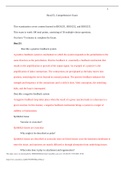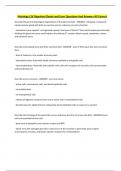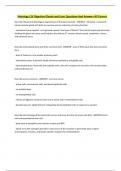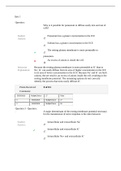Describe acinus structure Study guides, Class notes & Summaries
Looking for the best study guides, study notes and summaries about Describe acinus structure? On this page you'll find 15 study documents about Describe acinus structure.
All 15 results
Sort by

-
BIOS 255 Week 8 Comprehensive Exam (50 MCQs) | 100% CORRECT ANSWERS
- Exam (elaborations) • 7 pages • 2022
-
Available in package deal
-
- $12.49
- 6x sold
- + learn more
Bios255, Comprehensive Exam This examination covers content learned in BIOS251, BIOS252, and BIOS255. This exam is worth 100 total points, consisting of 50 multiple-choice questions. You have 75 minutes to complete the Exam. Bios251 Describe a positive feedback system A positive feedback system is mechanism in which the system responds to the perturbation in the same direction as the perturbation. Positive feedback is essentially a feedback mechanism that results in the amplification or growth o...

-
Histology L26 Digestive Glands and Liver Questions And Answers All Correct
- Exam (elaborations) • 6 pages • 2024
-
- $15.99
- + learn more
Histology L26 Digestive Glands and Liver Questions And Answers All Correct Describe the general histological organization of the pancreas (LO) - ANSWER-- lobulated, compound, tubulo-alveolar gland with both an exocrine and an endocrine secretory function - connective tissue support: no organized capsule; thin layer of loose CT from which septa pass internally dividing the gland into many small lobules; the delicate CT contains blood vessels, lymphatics, nerves, and excretory ducts Descr...

-
Histology L26 Digestive Glands and Liver Questions And Answers All Correct
- Exam (elaborations) • 6 pages • 2024
-
- $12.99
- + learn more
Histology L26 Digestive Glands and Liver Questions And Answers All Correct Describe the general histological organization of the pancreas (LO) - ANSWER-- lobulated, compound, tubulo-alveolar gland with both an exocrine and an endocrine secretory function - connective tissue support: no organized capsule; thin layer of loose CT from which septa pass internally dividing the gland into many small lobules; the delicate CT contains blood vessels, lymphatics, nerves, and excretory ducts Descr...

-
BIO 669 Human Pathology - Module 6 - Pulmonology Quiz Study Guide,100% CORRECT
- Exam (elaborations) • 61 pages • 2022
-
- $15.99
- + learn more
BIO 669 Human Pathology - Module 6 - Pulmonology Quiz Study Guide HUMAN PATHOPHYSIOLOGY Module 6 - Pulmonary System Quiz PROFESSOR KEY POINTS: Structure and Function of the Pulmonary System Teaching Focus • The pulmonary system consists of the lungs, airways, chest wall, diaphragm, and pulmonary and bronchial circulation. • Air is inspired and expired through the conducting airways, which include the nasopharynx, oropharynx, trachea, bronchi, and bronchioles to the sixteenth divis...

-
BIO 669 Human Pathology - Module 6 - Pulmonology Quiz Study Guide,100% CORRECT
- Exam (elaborations) • 61 pages • 2022
-
- $15.49
- + learn more
BIO 669 Human Pathology - Module 6 - Pulmonology Quiz Study Guide HUMAN PATHOPHYSIOLOGY Module 6 - Pulmonary System Quiz PROFESSOR KEY POINTS: Structure and Function of the Pulmonary System Teaching Focus • The pulmonary system consists of the lungs, airways, chest wall, diaphragm, and pulmonary and bronchial circulation. • Air is inspired and expired through the conducting airways, which include the nasopharynx, oropharynx, trachea, bronchi, and bronchioles to the sixteenth divis...

-
Pathophysiology Exam Test #3 Part 1 and 2 Completed with 100% correct Answers
- Exam (elaborations) • 36 pages • 2022
-
Available in package deal
-
- $15.60
- + learn more
Pathophysiology Exam Test #3 Part 1 and 2 Completed with 100% correct Answers Pathophysiology Exam Test #3 Part 1 and 2 Patho Test #3 part 2 When discussing body fluid, it is correct to state that: A: two-thirds of the body's water is intracellular. B: one-fourth of the body's fluid is extracellular. C: the two main extracellular compartments are interstitial and intracellular. D: standard total body water is 40% of body weight. A: two-thirds of the body's water is intracellular. ...

-
NURS 611 Exam 4 Questions & Answers (test-bank) Latest 2019/20 verified guide, Answers explained - Maryville University Of St. Louis.
- Exam (elaborations) • 139 pages • 2020
-
- $30.49
- 2x sold
- + learn more
NURS 611 Exam 4 Questions & Answers Chapter 24: Structure and Function of the Reproductive Systems MULTIPLE CHOICE 1. The initial reproductive structures of the male and female embryos appear the same until which week of gestation? a. Third c. Twentieth b. Eighth d. Thirtieth 2. The absence of which major hormone is a determinant of sexual differentiation (wolffian system) in utero? a. Estrogen c. Growth hormone b. Progesterone d. Testosterone 3. Which gland produces the associated horm...

-
NSG 5003 Questions and Answers_Latest,100% CORRECT
- Exam (elaborations) • 42 pages • 2021
-
- $19.47
- + learn more
NSG 5003 Questions and Answers_Latest Quiz 1 Question : Why is it possible for potassium to diffuse easily into and out of cells? Student Answer: Potassium has a greater concentration in the ICF. Sodium has a greater concentration in the ECF. The resting plasma membrane is more permeable to potassium. An excess of anions is inside the cell. Instructor Explanation: Because the resting plasma membrane is more permeable to K+ than to Na+, K+ can easily diffuse from its area of higher concentration ...

-
NUR 631 Advanced Physiology And Pathophysiology Test Bank Chapter 34-39;Graded A
- Exam (elaborations) • 59 pages • 2020
-
- $25.98
- 1x sold
- + learn more
Chapter 34: Structure and Function of the Pulmonary System Chapter 35: Alterations of Pulmonary Function Chapter 36: Alterations of Pulmonary Function in Children Chapter 37: Structure and Function of the Renal and Urologic Systems Chapter 38: Alterations of Renal and Urinary Tract Function Chapter 39: Alterations of Renal and Urinary Tract Function in Children 12. The adequacy of a person’s alveolar ventilation is assessed best by monitoring which mechanism? a. Ventilatory rate c. Respirato...

-
NSG 5003 Questions and Answers_Latest,100% CORRECT
- Exam (elaborations) • 43 pages • 2021
-
- $19.49
- 1x sold
- + learn more
NSG 5003 Questions and Answers_Latest Quiz 1 Question : Why is it possible for potassium to diffuse easily into and out of cells? Student Answer: Potassium has a greater concentration in the ICF. Sodium has a greater concentration in the ECF. The resting plasma membrane is more permeable to potassium. An excess of anions is inside the cell. Instructor Explanation: Because the resting plasma membrane is more permeable to K+ than to Na+, K+ can easily diff...

Do you wonder why so many students wear nice clothes, have money to spare and enjoy tons of free time? Well, they sell on Stuvia! Imagine your study notes being downloaded a dozen times for $15 each. Every. Single. Day. Discover all about earning on Stuvia


